Miniature artillery systems: from amusing cannons to reactive artillery systems
The fact is that in tsarist Russia, many rich landowners in the estates were miniature tools. They were used for decorative purposes, for launching fireworks, as well as for teaching noble children to military affairs. It should be noted that among these “toys” there were no layouts, they could all shoot with a core or with a canister. At the same time, the core's killing power was at least 640 meters or 300 fathoms.
Until the beginning of the XIX century, these guns were actively used during military operations. For example, Poles and Crimean Tatars suffered significant losses from similar artillery systems in the 17th century during the battles with the Cossacks.
Zaporozhye and Don Cossacks in horse and sea trips often used falconet and cannon caliber 0,5-3 pounds, as well as light mortars of caliber from 4 to 12 pounds. Such artillery was loaded onto horses, and during the battle it was transferred manually. Also, such guns were easily installed on the canoes (as a rule, on wet branches). During the defense, light small-caliber guns were mounted on carts forming a camp. When firing from falconet and cannons, nuclei and canister were used, and mortars - explosive grenades.
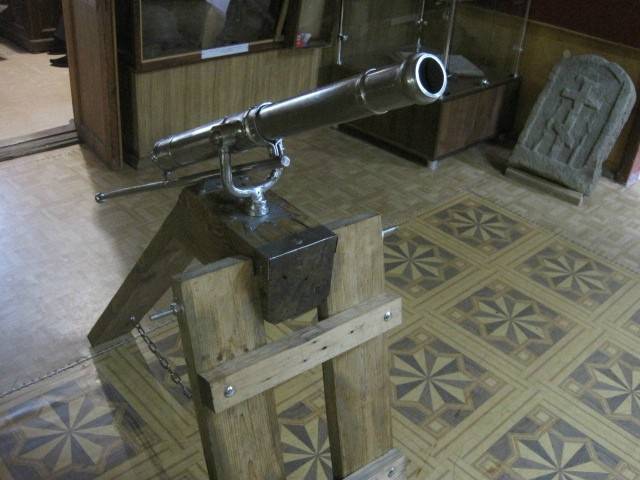
Falconet - translated from French and English is translated as a young falcon, a falcon. So in the old days they called artillery guns with a caliber of 45-100 mm. In the XVI-XVIII centuries. they were in service in the armies and fleets different countries of the world ("Chernyshkovsky Cossack Museum")
The use of such tools by Cossacks in campaigns gave them a significant advantage over the enemy. For example, the superior forces of the Polish cavalry surround the Cossack detachment. In direct confrontation, the outcome of the battle would have been predetermined: the Cossacks would not have emerged victorious. But the Cossacks are rather maneuverable — they quickly rebuilt their ranks and surrounded the squadron with carts. The winged hussars are attacking, but they fly into a barrage of fire from small artillery and pishchal. In the XVII century, the Poles had practically no light artillery, and it was quite difficult to drag in heavy guns of large and medium caliber in a maneuverable war. In the clashes with the Tatars, the Cossacks had a significant advantage - the enemy had no light artillery at all.
In the 18th century, mini-guns were used in the Russian army quite rarely: in the Chasseurs regiments, in the mountains, etc. However, even during this period interesting samples of small-caliber artillery were created, although they were not portable. This includes the 44-receiver 3-pound (76-millimeter) mortar battery of the system of A. K. Nartova. This gun was made in the St. Petersburg arsenal in 1754 year. The battery system consisted of bronze 76 millimeter mortars 23 centimeters long each. The mortars, mounted on a horizontal wooden circle (diameter 185 cm), were divided into 8 sections of 6 or 5 mortars in each and connected by a common powder shelf. The trunk part of the carriage was equipped with a screw lifting mechanism to impart an elevation angle. Such batteries are not widely spread.
Another similar system is the 25-barrel 1 / 5-pound (caliber 58 mm) mortar battery of the system of captain Chelokaev. The system was manufactured in 1756. The Chelokaev system battery consists of a rotating wooden drum with five rows of forged iron barrels fixed on it, with five barrels in each row. In the breech section, the trunks in each row for the production of volley fire were connected by a common powder shelf with a closed lid.
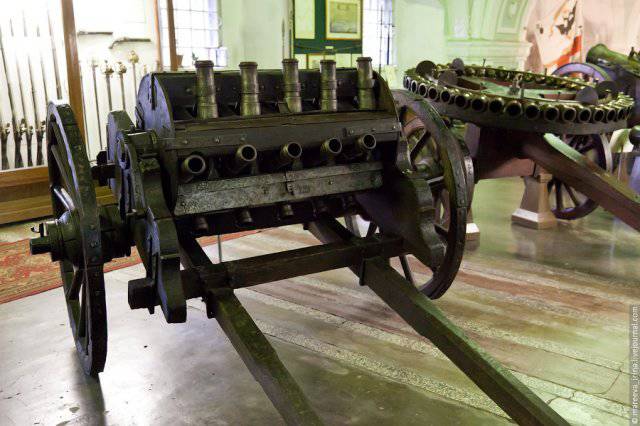
1 / 5-pound (58-mm) 25-barreled mortar battery of the system of captain S.Chelokayev, manufactured in 1756 g (Museum of Artillery, St. Petersburg)
In addition to these clearly experimental instruments, some types of troops were armed with hand-held mortars — tools for throwing long-range hand grenades. It was impossible to use these guns as an ordinary gun, that is, putting the butt against the shoulder, because of the high recoil. In this connection, the mortar was rested in the ground or in the saddle. These included: Hand Pz mortars (caliber 66 mm, weight 4,5 kg, length 795 mm) Hand Dragoon mortars (caliber 72 mm, weight 4,4 kg, length 843 mm) Hand bombardirsky mortars (caliber 43 mm, weight 3,8 kg, length 568 mm).
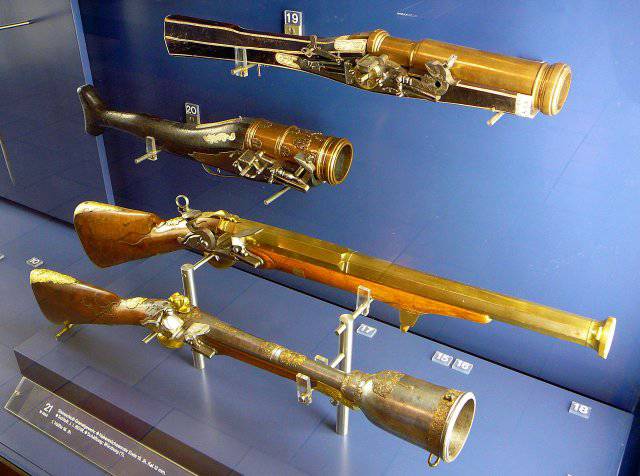
German mortars of the 16th — 18th centuries on display at the Bavarian National Museum, Munich. Below is a cavalry carbine with a mortar welded to the barrel.
Emperor Paul I abolished not only the toy cannons, but also the regimental artillery. In this regard, in the Russian cavalry and infantry division until 1915, saber, pistols and guns remained the only weapons. During the fighting, an artillery brigade was attached to a division, the commander of which passed into submission to the division commander. Such a scheme worked well during the Napoleonic wars, when battles took place mainly on the great plains.
In the period from 1800 to 1915 year, all Russian field guns had the same weight and size characteristics: weight in a combat position of about 1000 kg, wheel diameter 1200-1400 millimeters. The Russian generals did not even want to listen to other artillery systems.
But during the First World War, all the opposing sides quickly realized that to drive in the open field dense columns of troops was the same as simply shooting them. The infantry began to hide in the trenches, and the terrain was chosen for the offensive. But, alas, the loss of manpower from the enemy machine guns was enormous, and it was very difficult and in some cases impossible to suppress machine gun firing points with the help of the guns of the seconded artillery brigade. It took small guns that were supposed to be in the trenches next to the infantry, and during the offensive they were easily transferred or rolled manually by calculating from 3-4 people. Such tools were intended for the destruction of machine guns and enemy manpower.
The Rosenberg 37-mm gun was the first domestic specially designed battalion gun. MF Rosenberg, being a member of the artillery committee, was able to convince the Grand Duke Sergei Mikhailovich, the chief of artillery, to assign him to design this system. Having traveled to his estate, Rosenberg prepared a draft 37-millimeter cannon for a month and a half.
As the barrel was used 37-millimeter regular barrel, which served to shoot coastal guns. The barrel consisted of a barrel tube, a copper muzzle ring, a steel pinned ring and a copper knuckle screw that was screwed onto the barrel. Two-stroke piston shutter. Single-girder machine, wooden, rigid (there was no recoil device). The recoil energy was partially extinguished with special rubber buffers. The lifting mechanism had a screw that was attached to the tide of the breech and was screwed into the right-hand stanitsa of the sled. There was no turning mechanism - the trunk of the machine moved for turning. The machine was equipped with a 6 or 8 mm shield. At the same time, the 8-mm shield could easily withstand a Mosin rifle bullet fired at an emphasis.
The system can be easily disassembled into two parts with a mass of 106,5 and 73,5 kg for a minute. On the battlefield, the gun was transported by three manual numbers. For the convenience of movement by means of parts, a small rink was attached to a trunk bar. In winter, the system was installed on skis. In the campaign tool could be transported in several ways:
- in the hull, when two shafts are attached directly to the mast;
- on a special front end (quite often made on its own, for example, the boiler was removed from the camp kitchen);
- on the cart. As a rule, the 3 paired carts of the 1884 model of the year were assigned to the infantry units for two guns. In two wagons transported by gun and 180 cartridges, on the third carriage - 360 cartridges. All cartridges fit into the boxes.
The prototype Rosenberg gun in the 1915 year was tested and under the designation "37-mm gun model 1915 of the year" adopted for service. This name stuck in official papers, and in parts.
At the front, the first Rosenberg guns appeared in the spring of the 1916 of the year. Soon the old trunks were sorely missed, and by order of the Obukhov plant, GAU's order from 22.03.1916 ordered the manufacture of 37 barrels for 400-millimeter guns of Rosenberg. By the end of 1919, only 342 of the trunk was sent from this order, the remaining 58 were ready for 15%.
1917 X-guns of Rosenberg were sent to the front by the start of 137. In the first half of the year it was supposed to send more 150 guns. According to the plans of the Russian command, each infantry regiment should have 4 trench guns. Accordingly, 687 guns should have been in the 2748 shelves, besides, 144 guns per month were required for a monthly replenishment loss.
Alas, these plans were not implemented due to the collapse of the army that began in February 1917 and the collapse of the military industry, which followed with some delay. Despite this, the guns continued to be in service, but were somewhat modified. Since the wooden carriage was quickly failing, the military technician Durlyakhov created an iron machine for Rosenberg’s gun in 1925. In the Red Army on 01.11.1936, there was a Rosenberg 162 gun.
In September, the 1922 of the Red Army's Main Artillery Directorate issued an assignment to develop battalion artillery systems: 76-mm mortars, 65-mm howitzers and 45-mm guns. These guns were the first artillery systems that were created under Soviet rule.
For battalion artillery, the choice of calibers was not accidental. It was decided to abandon the 37-millimeter guns, since the fragmentation projectile of this caliber had a weak effect. At the same time in the warehouses of the Red Army there were a huge number of 47-millimeter shells from Hotchkiss naval guns. During the grinding of the old leading belts, the caliber of the projectile was reduced to 45 millimeters. That's where the caliber 45 mm came from, which was neither in the fleet nor in the army until the 1917 year.
In the period from 1924, then 1927 was made several dozen prototypes of miniature guns with quite a large striking power. Among these guns, the 65-mm howitzer military technician Durlyakhov was the most powerful. Its mass was 204 kilogram, firing range - 2500 meters.
The main rival of Durlyakhov in the "competition" was Franz Lender, who presented for testing an entire collection of systems: the 60-mm howitzer and the 45-mm gun of low and high power. An interesting fact is that Lender's systems had the same mechanisms that were used in large tools, that is, they were equipped with anti-recoil devices, lifting and turning mechanisms, etc. Their main advantage was that the fire could be fired not only from metal rollers, but also from traveling wheels. Systems on skating rinks had a shield, but with traveling wheels, the installation of a shield was impossible. The systems were made both non-separable and collapsible, while the latter were divided into 8, which made it possible to transfer them to human packs.
No less interesting development of the time is the 45-millimeter gun system Sokolov A.A. The barrel for the prototype of low power was manufactured at the Bolshevik plant in 1925, and the carriage was manufactured at the Krasny Arsenal plant in 1926. The system was finished at the end of 1927 and immediately transferred to factory tests. The barrel of the Sokolov 45-mm cannon was fastened with a casing. Valve wedge vertical semi-automatic. Rollback brake - hydraulic, spring tensioner. A large angle of horizontal guidance (up to 48 degrees) was provided by sliding beds. Lifting gear sector type. In fact, it was the first domestic artillery system with sliding beds.
The system was designed for shooting from the wheels. Suspension absent. The cannon on the battlefield was easily rolled by three numbers of calculation. In addition, the system could be disassembled into seven parts and transferred to human bags.
All battalion artillery systems caliber 45-65 millimeters fired armor-piercing or fragmentation shells, as well as canister. In addition, the Bolshevik plant produced a series of “nadulnykh” mines: - for 45-millimeter cannons - 150 pieces (weight 8 kilograms); for 60 millimeter howitzers - 50 pieces. However, the Main Artillery Directorate refused to adopt above-caliber mines for armament. It should be noted that during the Great Patriotic War, the Germans widely used on the eastern front over-caliber projectiles as anti-tank of 37-millimeter cannons, and heavy high-explosive from 75- and 150-millimeter-infantry guns.
Of all these artillery systems, only the 45-mm Lender low-power cannon was adopted. It was produced under the designation "45-millimeter battalion howitzer model 1929 of the year." However, only 100 units were manufactured.
The reason for the cessation of the development of mini-guns and howitzers was the adoption in 1930 of the 37-millimeter anti-tank gun, acquired from the company Rheinmetall. This tool for its time had a fairly modern design. The gun had a sliding bed, unsprung wheel travel, wooden wheels. It was equipped with a horizontal wedge gate with 1 / 4 automatics, spring-loaded knurling and hydraulic recoil brake. The spring of the bobbin was placed on the compressor cylinder. The recoil devices after a shot rolled back with the barrel. The fire could be conducted with a simple sighting tube, which has a field of view of 12 degrees. The gun was put into production at the Moscow-based Kalinin Plant No. XXUMX, where it was assigned the factory index 8-K. The guns were made semi-handy, with manual fitting of parts. In 1, the plant presented 1931 guns to the customer, but did not deliver any of them due to poor build quality. In 255, the plant handed over 1932 guns, the next - 404. In 105, the production of these guns was stopped (in 1932, the guns were surrendered from the reserve of the previous year). The reason was the adoption by the 1933-mm anti-tank gun model 45 of the year (1932-K) more power, which was the development of 19-K.
Not the least role in curtailing the program of creating mini-cannons was played by the enthusiasm of the leadership of the Red Army, first of all Tukhachevsky M.N., recoilless cannons.
In 1926-1930, besides mini-guns, six prototypes of 76 caliber mini-mortar were made. These guns were distinguished by high mobility achieved primarily due to the small mass (from 63 to 105 kilograms). The firing range was 2-3 thousand meters.
The design of mortars used several very original solutions. So, for example, ammunition of three samples of mortars of the design office of NTK AU included shells with ready projections. Sample No. 3 at the same time had a gas-dynamic ignition scheme, in which the charge burned in a separate chamber, which was connected to the barrel bore with a special nozzle. For the first time in Russia, a gas-dynamic crane was used in the mortar crane (developed by Glukharev, Shchelkov, Tagunov).
Unfortunately, these mortars were literally devoured by mortar constructors, at the head of which “stood” N. Dorovlev Mortar guns almost completely copied the Stokes-Brandt mortar of the 81 mm caliber and did everything to ensure that systems that were able to compete with the mortars were not accepted.
Despite the fact that the accuracy of firing 76-millimeter mortars was significantly higher than that of 82-millimeter mortars of the beginning of 1930-s, the work on creating mortars was stopped. It is curious that 10 August 1937, one of the prominent mortar men Shavyrin BI received an author's certificate for a mortar equipped with a remote valve for releasing some gases into the atmosphere. It was long ago forgotten about the mortar of the civilian carriage in our country, but it was not appropriate to speak about mortars and cannons with a gas faucet manufactured in Poland, Czechoslovakia and France.
In the Soviet Union, in the second half of the 1930-ies, two original 76-millimeter mini-howitzers were created: 35 K design Sidorenko V.N. and Ф-23 designs by Grabin V.G.
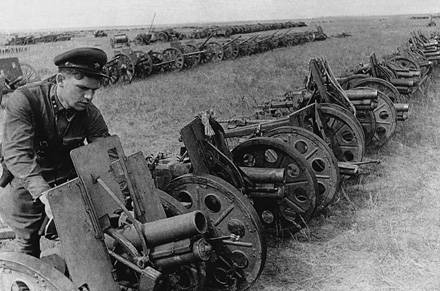
35 To the design Sidorenko V.N.
The folding barrel of the 35 K howitzer consisted of a pipe, a lining and a breech. The breech screwed onto the pipe without using a special tool. Eccentric piston lock. The slope is constant. Lifting gear with one sector. Rotation was carried out when moving the machine along the axis. The hydraulic brake recoil spun type. Knuckle spring. Single-gang carriage, box-shaped, disassembled into the trunk and frontal parts. Trunk part when firing from a trench was filmed. The 35 K howitzer used a sight from an 76 millimeter cannon of the 1909 model of the year, with some changes that allowed firing at angles up to + 80 degrees. Shield folding and removable. Crankshaft axle. By rotating the axis, the height of the line of fire could change from 570 to 750 millimeters. The front of the system is global. Wheels disk with a freighter. The 76-mm howitzer 35 K could be disassembled into 9 parts (the mass of each 35-38 kg), which made it possible to transport the gun in unassembled form on both four horse and nine human packs (without considering ammunition). In addition, the howitzer could be transported on the wheels of 4 by the calculation people or in the hull harness of one horse.
F-23 howitzer barrel - monoblock. Muzzle brake was absent. The design used a piston slide from the 76-mm regimental gun of the 1927 model. The main feature of the Grabin howitzer design was that the axle of the trunnions did not run through the central part of the cradle, but its rear end. Wheels in the fighting position were behind. The cradle with the barrel during the transition to the stowed position turned back almost 180 degrees relative to the axle axis.
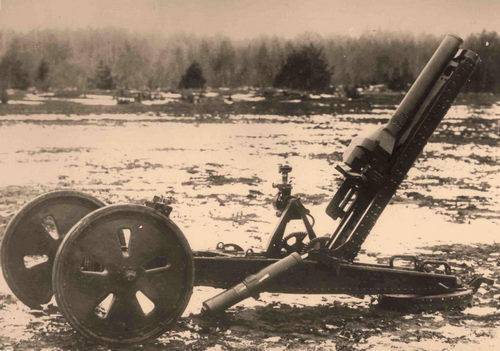
X-NUMX-mm F-76 battalion cannon when firing at a high elevation angle. The second version of the F-23 was developed at the same time, and during testing on the 23-shot, the recoil systems and the lifting mechanism failed
Do I have to say that the mortar lobby has taken all to thwart the adoption of the F-23 and 35 K? For example, in September 1936 of the year during the second testing ground of the 76 K 35 K howitzer during firing, the frontal link broke because there were no bolts that held the shield bracket and frontal part. Probably, someone took out these bolts or “forgot” to put. In February 1937, the third test took place. And again, someone "forgot" to pour liquid into the compressor cylinder. This “forgetfulness” led to the fact that the frontal part of the machine was deformed due to the strong impact of the barrel during firing. 7 April 1938, outraged Sidorenko V.N. I wrote a letter to the artillery department saying: “Plant # 7 in the 35 K completion is not interested - it threatens the plant with gross arbitrariness ... You have a department that is a staunch supporter of mortars, and therefore an enemy of mortars, 35 K”.
Unfortunately, at that time neither Sidorenko nor Grabin wanted to hear in the artillery administration, and the work on both systems was stopped. And only in 1937, the NKVD summed up the complaints of Sidorenko and some other designers, and then the leadership of the Main Artillery Directorate, as they say, "thundered to fanfare."
The new leadership of GAU in December 1937 of the year decided to again raise the issue of 76-mm mortars. A third-rank military engineer of the artillery administration, Sinolitsyn, wrote in conclusion that the sad end stories with battalion mortars of caliber 76 mm "is a direct act of sabotage ... In my opinion, work on light mortars should be resumed immediately, and all mortars made earlier, scattered around landfills and factories, should be found."
"Guns toys" massively and fairly successfully used by our opponents - the Japanese and Germans.
So, for example, the armament of the Japanese army in 1934 received a 70-mm howitzer gun mod. 92. Her weight was 200 kilograms. The carriage had sliding cranked beds, so the howitzer had two positions: high +83 with an elevation angle of a degree and low - 51 degrees. The angle of horizontal guidance (40 degrees) made it possible to effectively destroy the lungs Tanks.
In the 70-mm howitzer, the Japanese made a unitary loading, but the sleeves were made either detachable or with a free fit of the projectile. In both cases, before shooting, the calculation could change the amount of charge, screwing the bottom part of the sleeve or removing the projectile from the sleeve.
The 70-mm high-explosive fragmentation projectile weighing 3,83 kilogram was equipped with 600 grams of explosive, that is, its quantity was equal to that of the Soviet 76-millimeter high-explosive fragmentation grenade OF-350, which was used for regimental and divisional guns. The range of firing Japanese howitzer cannon caliber 70 mm was 40-2800 meters.
According to the Soviet closed reports, the Japanese 70-mm howitzer cannon performed well during battles on rough terrain in China, as well as on the Khalkhin-Gol river. The shells of this gun were hit by dozens of tanks BR and T-26.
The main means of supporting the German infantry during the war years was a light 7,5-cm infantry gun. The mass of the system was only 400 kilograms. The cumulative weapon projectile was able to burn through armor up to 80 millimeters thick. The split-sleeve loading and the elevation angle to 75 degrees allowed this tool to be used as a mortar, but it provided much better accuracy. Unfortunately, there were no such weapons in the USSR.
In the Soviet Union, in the prewar years, several types of company miniature anti-tank guns were developed - the INN-20 X-mm millimeter cannon of the system Vladimirova SV and Biga M.N., 10-mm gun TsKBSS-20 system Korovin SA, 51-mm gun Mikhno and Tsirulnikov (25 K), 43-millimeter Spit gun and some others.
For various reasons, none of these weapons were ever put into service. Among the reasons was the lack of attention of GAU to company anti-tank guns. With the outbreak of hostilities, the fronts literally shouted about the need for company anti-tank guns.
And here Sidorenko A.M., Samusenko M.F. and Zhukov I.I. - three teachers of the Artillery Academy, which was evacuated to Samarkand, - within a few days designed the original anti-tank gun LPP-25 caliber 25 mm. The gun had a wedge bolt with a copier semi-automatic swing type. The tool had a front "opener-hoof" and self-closing openers openers. This increased stability at the behest of the fire and ensured the convenience and safety of the gunner when working from the knee. The features of BOB-25 include an articulated pivoting axle for raising the gun to the stowed position during transport behind the tractor. The quick preparation of the weapon for the battle was provided by a simple pin-mount for traveling. Soft cushioning was provided by springs and pneumatic wheels from the M-72 motorcycle. The transfer of the weapon to the combat position and its carrying by calculating the human 3 ensured the presence of two vag. A rifle optical sight or a “Duck” sight could be used for targeting.
Combining some elements of the guns, which were already in service, the designers created a unique system that was lighter in mass than the standard 45-millimeter anti-tank gun mod. 1937 in 2,3 times (240 kg versus 560 kg). Penetration at the 100 distance was higher in 1,3 times, and at 500 distance in the 1,2. And this is when using a conventional armor-piercing-tracer shell 25-mm anti-aircraft gun arr. 1940, and in the case of the use of a subcaliber projectile with a tungsten core, this figure increased even 1,5 times. Thus, this weapon was capable of penetrating the frontal armor of all German tanks that were used at the end of 300 on the eastern front at a distance of up to 1942 meters.
Gun firing rate equaled 20-25 shots per minute. Thanks to the cushioning, the gun could be transported along the highway at a speed of 60 km / h. The height of the line of fire was 300 mm. The high mobility of the system made it possible to use it not only in infantry units, but also in airborne units.
The system in January 1943 of the year successfully passed the factory tests. But soon the work on the gun stopped. The only surviving sample of the LPP-25 cannon is on display at the museum of the Peter the Great Academy.
It is possible that the work on LPP-25 was stopped due to the start of the development of a special airborne cannon Chek-МХNUMX of caliber 1 mm. This tool was designed under the leadership of Charnko and Komaritsky in OKBL-37 in 46 year.
The 37 mm 1944 model airborne cannon is an anti-tank light artillery system with reduced recoil. The internal structure of the barrel, as well as the ballistics of the gun were taken from the automatic anti-aircraft gun model 1939 year. The barrel consists of a pipe, breech and muzzle brake. Powerful single-chamber muzzle brake significantly reduced the recoil energy. The recoil devices mounted inside the casing are built according to the original scheme - a hybrid of the double-rollback system and the scheme of the recoilless cannon. The recoil brake was absent. 4,5-mm shield cover, attached to the casing, protected the calculation from the bullets, the shock wave of a close gap and small fragments. Vertical guidance is carried out by a lifting mechanism, horizontal - by the gunner’s shoulder. Two-wheeled machine. There were sliding bed with constant and driving openers. The wheel course is sprung. The height of the line of fire was 280 millimeters. Weight in the combat position about 215 kilograms. The rate of fire is from 15 to 25 shots per minute. At a distance of 300 meters, the gun pierced the armor with a thickness of 72 mm, and at a distance of 500 meters - 65-mm.
During the military tests, the wheel course and shield were separated from the 37-mm cannon, after which it was installed on a tubular welded frame, from which it was possible to shoot from the GAZ-64 and Willys vehicles. In the 1944 year, even the Harley Davidson motorcycle was adapted for shooting. Two guns were laid on each gun. One served to accommodate the gun, gunner, loader and driver, the second - the commander, podnoschika and driver. Shooting could be carried out on the move with a motorcycle installation when driving on a flat road at speeds up to 10 kilometers per hour.
During the flight tests, the landing of the cannons was carried out in gliders А-7, БДП-2 and Г-11. In each of them they loaded one cannon, ammunition and 4 man of calculation. In the aircraft Li-2 for parachuting loaded gun, ammunition and calculation. Discharge conditions: speed 200 km / h, height 600 meters. The flight test was carried out using a TB-3 bomber. Two GAZ-64 and Willys with 37 mm caliber guns mounted on them were suspended under the bomber's wing. When transported by landing method, according to the 1944 instructions of the year, a gun, a motorcycle 2 and a 2 man (crew and two drivers) were loaded onto a Li-6 plane, and another gun and cartridges were added to C-47. When parachuting, the gun and motorcycle were placed on the external suspension of the Il-4 bomber, and the cartridges and the calculation were on the Li-2. In the period from 1944 to 1945, the 472 XK-M1 cannons were manufactured by XNUMX.
In the history of "toy guns" after 1945, a new phase began with the use of reactive and recoilless (dynamo-reactive) systems.
Based on materials:
www.dogswar.ru
ljrate.ru
ww1.milua.org
vadimvswar.narod.ru
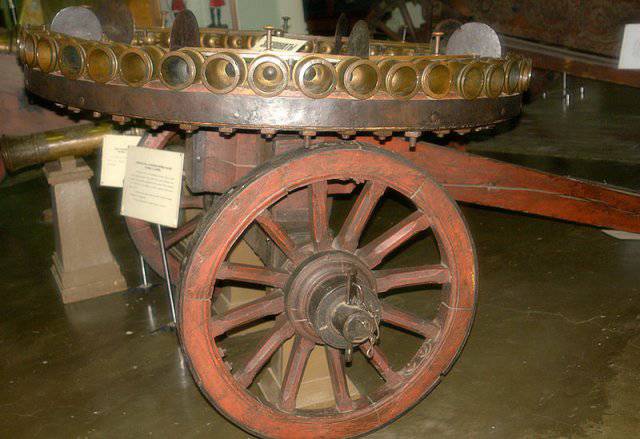
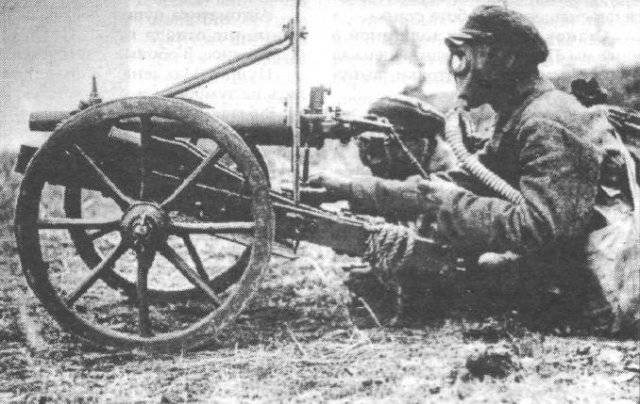
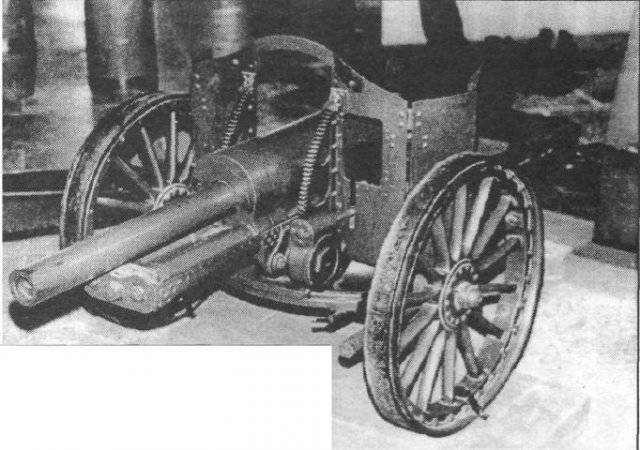
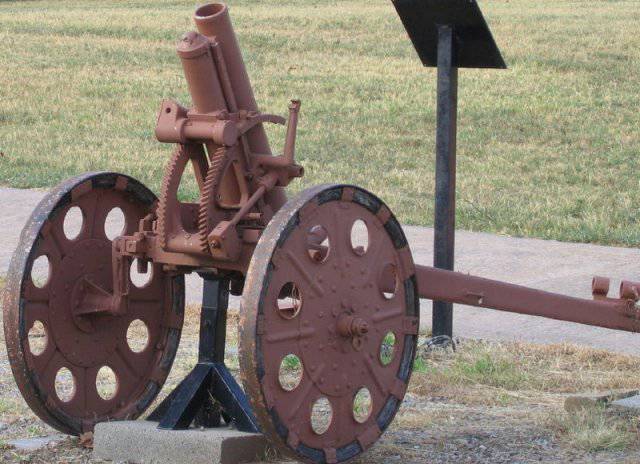
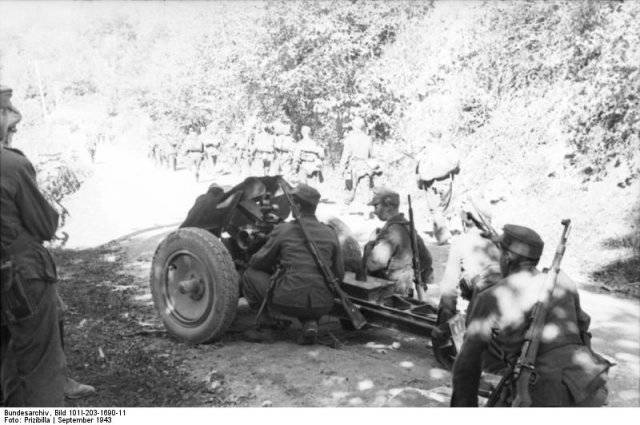
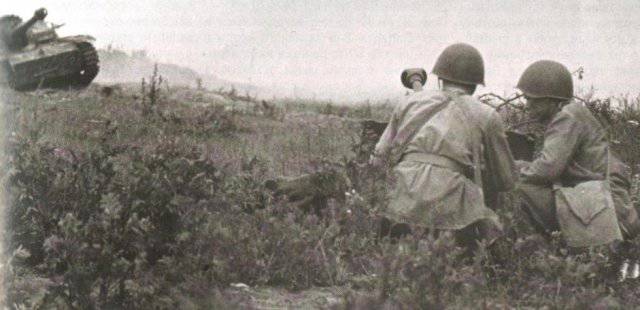
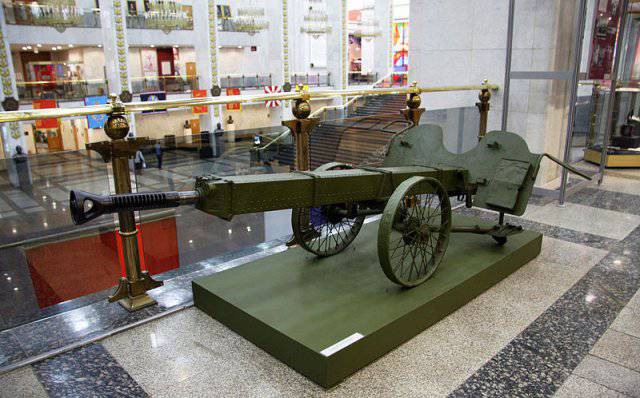
Information